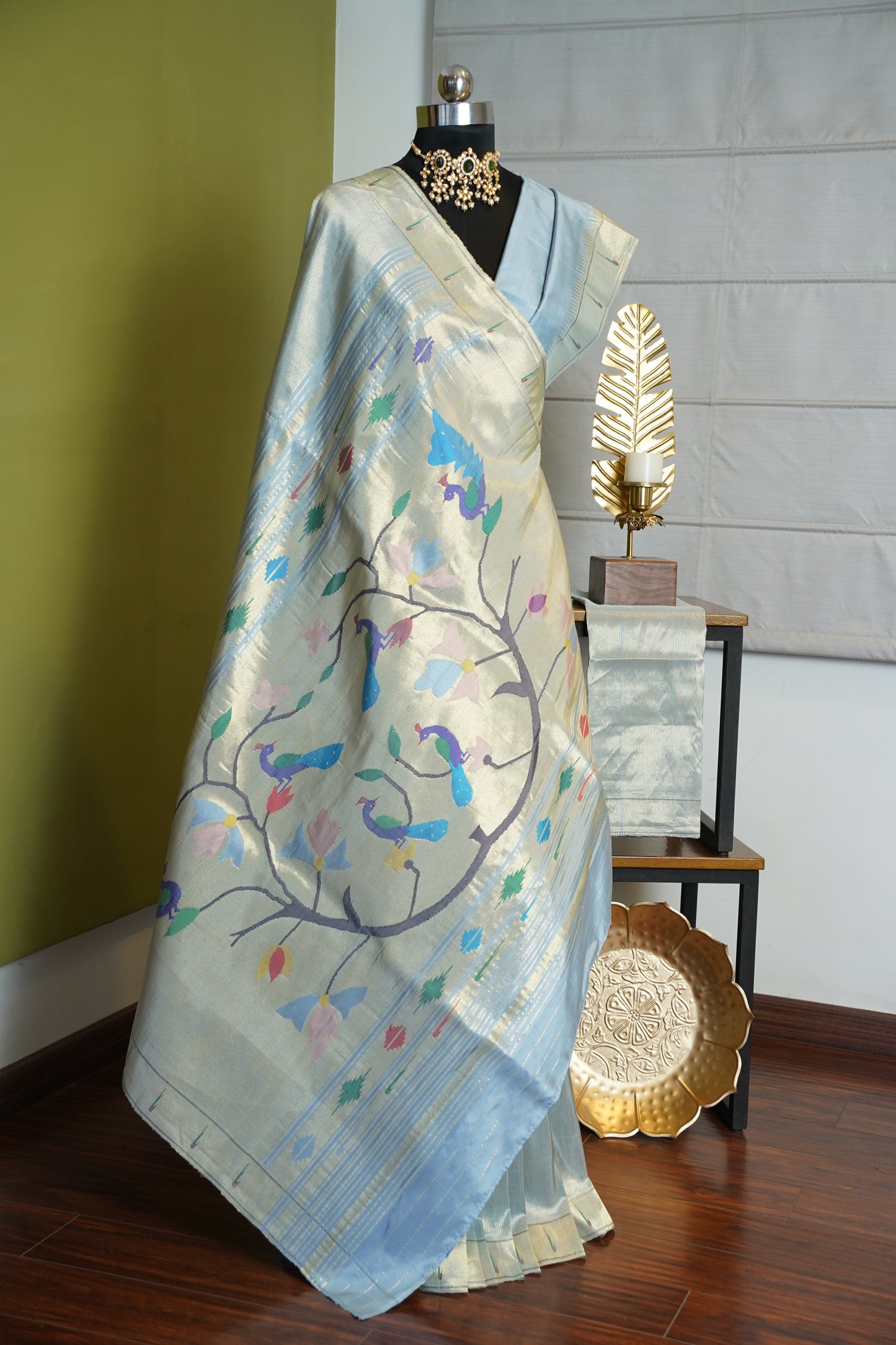Dull Blue & Gold Tissue Paithani with Double Peacock Pallu
Dull Blue & Gold Tissue Paithani with Double Peacock Pallu
Couldn't load pickup availability
Experience the allure of timeless tradition with our handwoven Dull Blue & Gold Tissue Paithani saree, meticulously crafted in the heritage town of Yeola. Perfect for those who appreciate artful elegance and bespoke luxury.
- Material: Pure Silk with Tissue
- Blouse Piece: One Blouse Piece
- Care Instructions: Dry Clean Only
- Customization: Bespoke Design Options Available Upon Request.
Indulge in the legacy of India's rich textile heritage with our Dull Blue & Gold Tissue Paithani Paithani Saree. Handwoven in the historic town of Yeola, each saree is a masterpiece that marries traditional techniques with modern design sensibilities. The distinctive Muniya Border paired with Double Peacock Pallu not only enhances its visual appeal but also underscores the exquisite craftsmanship that goes into every piece. Designed as an heirloom to be cherished across generations, this saree is perfect for special occasions, weddings, or when you simply want to celebrate your cultural heritage in style.
Disclaimer
- Paithanis are woven in two-tone colours.
- The colours look different from different angles.
- The camera or phone or device on which the photograph is viewed also distorts the colours.
- There may be some differences between the photo and the actual piece.


Authenticity, guaranteed.
-

100% Handcrafted
-

Made In India
-

Pure Silk Mark
-

Handloom Mark
Frequently Asked Questions
Are these genuine Paithanis?
Yes, all our Paithanis are hand woven on handlooms, using a technique that is more than five centuries old. Our master weavers are approved and certified by the Indian Government Ministry of Handlooms.
Where are the textiles woven?
All our textiles (sarees and dupattas) are woven by our team of master weavers who are based in Yeola, a small town in Maharashtra.
What is the yarn used for weaving?
We use only natural yarns, pure silk and pure cotton.
What is the zari used?
In most of our sarees we use ‘tested zari’, a high quality metallic thread. With proper care and maintenance, this zari will last for years and will not lose its luster.
Is real gold and silver used in the saree?
Although the ancient saris had real gold and silver in them, nowadays weavers have stopped using these precious metals. The aim is to keep costs under control and to make the Paithani saree more affordable. Artificial zari looks and behaves exactly like real silver. However we have used real silver zari in certain pieces and collections, and we also accept orders using silver zari if the client requests us to do so.
Why are Paithani sarees so heavy (weight)?
When a textile is woven on a hand loom, undergoes a lot of handling .The yarn has to be of a certain strength. For Paithani weaving, two ply yarns of silk have to be used. Anything thinner than 2 ply will make the fabric weak and compromise the life and the appearance of the saree. This is the reason that Paithanis are heavy in weight
Why are the sarees so stiff?
The silk yarns are coated with starch before they are put on the loom . The starch gives stability and strength to the fibres and helps fasten the weaving process. The starch along with the tension of the handloom, makes the fabric slightly stiff . A brand new saree is also roll pressed which adds to its crispness. After subsequent use, the silk yarns become pliable and soft. In case you prefer a softer drape, we recommend you to dry clean the piece before wearing it for the first time. Ensure that you get it done from a reputed dry cleaner.
What is ‘shot colour’ or ‘dhoop chaon’ effect?
In any woven textile. The vertical / lengthwise yarns are called ‘warp’ yarns and the horizontal yarns are called ‘weft’ yarns. A fabric is woven by interlacing the warp and the weft yarns. Sometimes we use different colours for warp and weft. After weaving, the resultant fabric will display both the colours when viewed from different angles. This effect is called ‘dhoop chaon’ or ‘shot colours’ (two toned). It is this unique feature, combined with the high lustre of silk, that makes the Paithani sarees look luxuriant and opulent.
What is a ‘Banarasi Paithani’?
Technically this term itself is wrong. When a saree is woven using the Banarasi / Jacquard weaving technique and if the designs mimic the traditional Paithani designs, most people get fooled into believing that it is a genuine Paithani saree.
Banarasi Paithanis / Kanjeevaram Paithanis / South Paithanis are NOT genuine Paithani sarees.
How do I know that I am buying a genuine Paithani saree?
Ask questions about the weaver and place of origin. Do verify if it is woven on a handloom. Sometimes sarees are woven on a Powerloom and just ‘look’ like a Paithani. Flip the saree and see the reverse side. A genuine Paithani will never have long ‘floats’ or yarns running across the motifs. The Paithani design looks exactly the same on the face as well as the reverse side.
How long does it take to weave a saree?
It can take minimum 45 to 60 days. ‘All over’/‘Jaal’ sarees can take upto a year.
Why does the weaving time differ?
Factors like design and motif play the main role in estimating time required. Unforeseen challenges like problems with weaver’s health and personal life can also affect the timeline.
All our pieces are handmade, from drawing the designs on paper, to dyeing, setting up the loom and the actual weaving process. Like all good things in life, these heirlooms take time and patience. The end result is worth the wait!
How can I place an order?
You can reach out to us via text or Whatsapp on +91 9881198540. Our designer will be happy to help you place an order.






